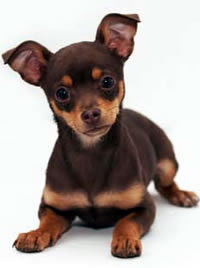|
The Canine Chronicles Directory
Chihuahua

Chihuahua's have two varieties: the short and the long hair. When showing this breed,
the smooth-haired variety should have a fine silky coat and the long-haired variety
should have a flat or slightly wavy coat. The ears should also drip with fringe
and the neck and legs should be well feathered. All colors of the breed are accepted
however there are a few preferred colors such as fawn, sand, chestnut, silver, and
steel blue. The skull is rounded or apple-shaped and the muzzle is pointed. Puppies
may have a soft spot or "molera" which closes as they mature into adulthood. The
large eyes should be well set apart and round in shape. In dark-coated dogs the
eyes should be dark and the nose black. In light-coated dogs, the eyes should be
ruby in color and the nose pink. Chihuahua's have large ears that stand erect in
a 45-degree angle from the skull. The teeth should meet in a level bite. The slightly
arched neck merges into sloping shoulders. The body is stout and the topline level.
The legs are straight and square shaped with the hindquarter hocks set well apart.
The feet are delicate with well-separated toes. The plume tail is sickle shaped
and should curve over the back.
|
|
Temperament
|
Chihuahua's are bold, affectionate, protective and loyal. However, they can also
be strong-willed and tend to only bond with one or two people. This can cause them
to become jealous towards other dogs and people. This breed may snap at children
who tease or abuse them. They are better with older children. Although they are
territorial, Chihuahua's when socialized from an early age, generally get along
with other dogs and household pets. This breed dislikes the cold and should wear
sweaters or jackets on colder days. Chihuahua's have a "big dog" mentality and will
not allow larger dogs to intimidate them.
|
|
Height, Weight
|
Height: 6-9" ; Weight: 2-6 lbs.
|
|
Health Problems
|
As with most dogs that have a short nose, Chihuahuas tend to snore and wheeze. Care
should be taken with its eyes as they are susceptible to glaucoma and dryness. They
are also prone to rheumatism, colds stress, gum problems and fractures. They may
need to have a cesarean in order to give birth. Sometimes the molera will remain
open throughout their life.
|
|
Living Conditions
|
Chihuahuas can live wonderfully in an apartment. They are active indoors and require
no yard. Keep this breed warm as they do not tolerate the cold very well. Keep a
little sweater or covering nearby in case of cold weather.
|
|
Exercise
|
This breed needs regular exercise so don't be tempted to carry them around with
you. Use a body harness instead of a collar.
|
|
Life Expectancy
|
15 or more years
|
|
Grooming
|
This breed is easy to groom. Gently brush with a soft bristle brush or wipe with
a damp cloth. Bathe about once per month and take care not to get water in the ears.
This breed is an average shedder.
|
|
Origin
|
The origin of the Chihuahua is mysterious however it is known that they are a very
ancient breed. This breed was discovered in Mexico although there are several theories
on how they arrived in this country. One theory is that they evolved from Egyptian
breeds exported to the Mediterranean and then imported to Mexico during the 1591
Spanish conquest. Another theory is that a breed resembling the Chihuahua was domesticated
by Aztecs in Mexico long before the conquest. The last and most popular theory is
that the breed dates back to the Mayan Civilization (5th century). Small carvings
depicting small Chihuahua-like images were found in pyramids located in Chichen
Itza, Yucatan and at the Monastery of Huejotzingo (located between Mexico City and
Pubela). The images were found in the Toltec stones, dating from the 9th century,
that were used to build the monastery. The small dog was known as "Techichi" in
the Toltec and Aztec cultures. Techichis were used as pets for the wealthy and were
an essential part of religious practices. Much like Egyptian culture, the Techichi
dogs were cremated and buried with their deceased owners. They were thought to take
on their owner's sins and guide them through the underworld. These dogs were thought
to have been bred with a hairless dog that came across the Bering Strait from Asia.
The breed was first exported to the United States in the 1850s and was first shown
in 1901. It is believed that the Long Coated variety was developed here by crossing
the smooth coated Chihuahua with a toy breed. The breeds that have been mentioned
are Papillons, Pomeranians, Pekingese, Yorkshire Terriers and Toy Poodles. The Chihuahua
was given AKC recognition in 1904, UKC recognition in 1948 and is known to be the
smallest breed in the world.
|
|
Group
|
AKC Toy, UKC Companion Dog
|